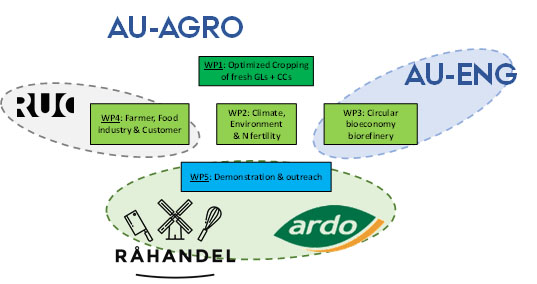GrainLegsgo
Fresh legumes for human consumption
Background
A more sustainable and greener European agricultural sector calls for a diet shift from meat to plant protein sources, which for many will also contribute to improved human health. Shifting towards a greater production of grain legumes for human consumption may improve agroecosystem services via increased soil fertility, diversified crop rotations and reduced climate and environmental impacts. Yet, the Danish organic area cultivated with grain legumes is very low (3.6%) and only a small part of this is for human consumption.
About the project:
In GrainLegsGo we will investigate the possibility of promoting the cultivation of legumes as food in Denmark (peas, faba beans, soybeans, green beans). An increased production of legumes will have both environmental and climatic benefits and also open up opportunities to contribute to the circular bioeconomy, as the biomass from the crops can be used for e.g. biogas or processed for use in, for example, the textile industry.
Project period: 01.01.2021-31.12.2024
Purpose
The aim of GrainLegsGo is to increase the cropping of fresh grain legumes for human consumption, while providing environmental and climate benefits and promoting circular bioeconomy. With a cross-disciplinary approach, GrainLegsGo brings key stakeholders together, increases consumers´ awareness and promotes the cropping of traditional and novel grain legumes for fresh harvest. By optimizing the cropping of grain legumes (screening of species and varieties for early harvest), GrainLegsGo increases the efficiency and productivity of organic arable systems, also thanks to more productive cover crops and lower infections of pests and diseases.
The project, step-by-step
During a three year period, the following activities are planned to take place:
- Grain legumes yield stability, nutritional value and biorefinery potential of residues are investigated
- Carbon (C) and nitrogen (N) flows and greenhouse gas emissions are documented to inform consumers and the public about the environmental and climate impact of fresh grain legumes production.
- Biorefinery of green grain legume residues, with focus on utilization of cellulose for textile production.
- A living lab is defined as a user-centered, iterative, open-innovation ecosystem, often operating in a territorial context (e.g. city, agglomeration, region or campus), integrating concurrent research and innovation processes within a public-private-people partnership.”
- Two company partners contribute to demonstrate results and reach stakeholders across the value chain.
Project leader

